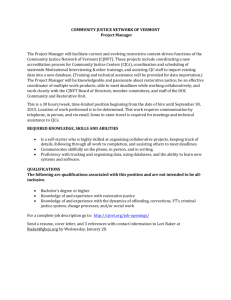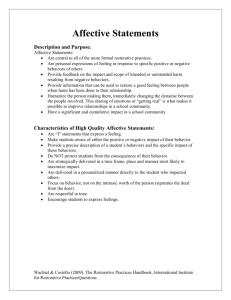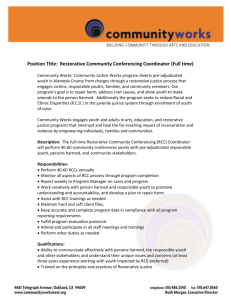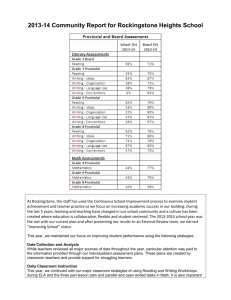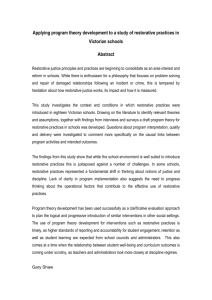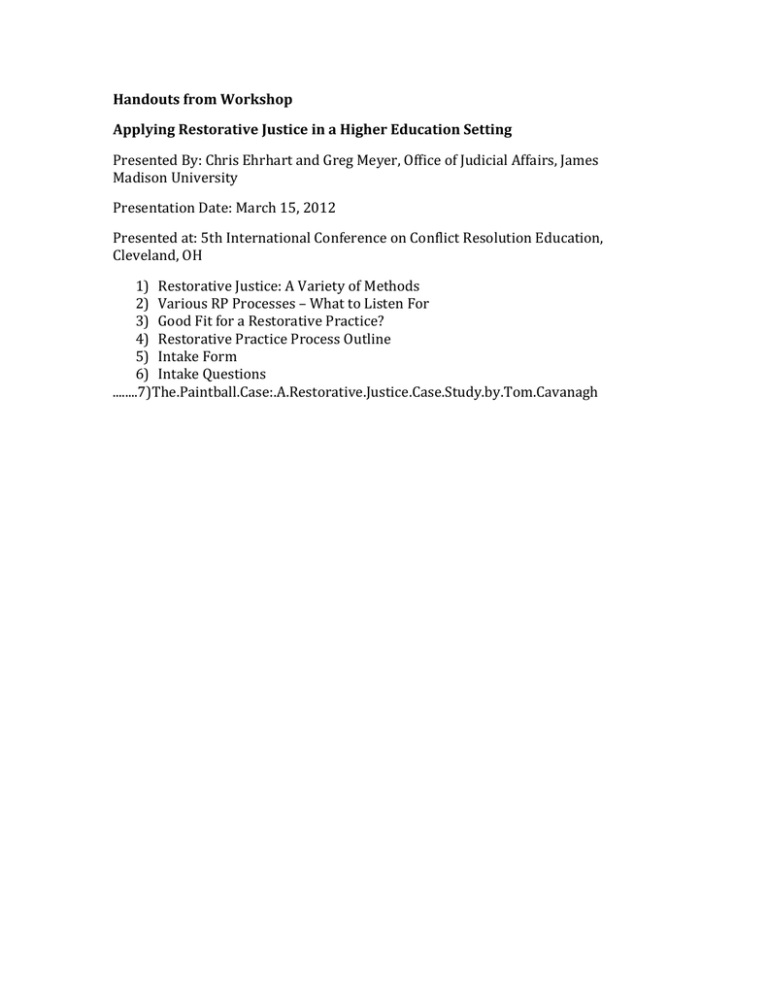
Handouts)from)Workshop)
Applying)Restorative)Justice)in)a)Higher)Education)Setting)))
Presented(By:(Chris(Ehrhart(and(Greg(Meyer,(Office(of(Judicial(Affairs,(James(
Madison(University(
Presentation(Date:(March(15,(2012(
Presented(at:(5th(International(Conference(on(Conflict(Resolution(Education,(
Cleveland,(OH(
1) Restorative(Justice:(A(Variety(of(Methods(
2) Various(RP(Processes(–(What(to(Listen(For(
3) Good(Fit(for(a(Restorative(Practice?(
4) Restorative(Practice(Process(Outline(
5) Intake(Form(
6) Intake(Questions
........7)(The.Paintball.Case:.A.Restorative.Justice.Case.Study.by.Tom.Cavanagh
Restorative Justice: A Variety of Methods
A restorative justice process is one in which the parties with a stake in a particular offense (the victim, the
offender, and community members) are supported and voluntarily participate, with the assistance of
facilitator, in a discussion of the circumstances surrounding the harm. The purpose is to understand its
underlying causes, the effects on those who have been harmed, and to address the parties’ needs for
healing and reparation. Restorative Justice provides opportunities to ask and answer questions, share
stories, express feelings, and hopefully develop a better understanding of the other.
The format can look differently depending on the needs of those involved. Community Group
Conferencing, Circle Processes, and Community Accountability Boards are a few of the many approaches
that can be used.
Victim-Offender Conferencing:
Victim-offender Conferencing, (also called victim-offender dialogue, victim-offender mediation, victimoffender reconciliation, or restorative justice dialogue), is usually a dialogue between victim and offender
with the support of a trained facilitator. This method generally involves few participants. Often the
conversation is just between the party or parties harmed and those that caused the harm.
(International Institute for Restorative Practices, http://www.iirp.edu/)
Community Group Conferences:
Restorative conferencing involves a larger amount of participants than victim-offender conferencing.
Restorative conferences, which have also been called restorative justice conferences, family group
conferences and community accountability conferences, is usually a facilitated meeting between
offenders, victims, and family and friends of each party, and the community in which they address harms
and needs as well as consequences and restitution.
(International Institute for Restorative Practices, http://www.iirp.edu/)
Circles:
Restorative Circles
Restorative circles allow prisoners to meet with their families and friends in a group process to support
their transition back into the community. Meetings specifically address the need for reconciliation with
victims of their crime(s).
(Federal Probation, http://www.uscourts.gov/uscourts/FederalCourts/PPS/Fedprob/201006/06_restorative_circles.html)
Sentencing Circles
Sentencing circles (sometimes called peacemaking circles) use traditional circle ritual and structure to
involve all interested parties. Sentencing circles typically employ a procedure that includes: (1)
application by the offender; (2) a healing circle for the victim; (3) a healing circle for the offender; (4) a
sentencing circle; and (5) follow-up circles to monitor progress.
Surrogate Victim Panels:
This is a process that can be used when a victim cannot or is not willing to take part in a dialogue. The
purpose of this program is to provide a safe, appropriate environment where people who have been
impacted by crime and people who have caused harm can talk about the impact of certain actions. The
party or parties that caused harm meet with surrogate victims of similar offenses to hear that person's
story of how the crime impacted their life. These panels are meaningful ways for juvenile offenders to
learn how their actions affect not only their victims, but their friends, family, and community.
(International Institute for Restorative Practices, http://www.iirp.edu/)
Restorative Justice
A restorative justice process is one in which the parties with a stake in a particular offense (the victim, the
offender, and community members) are supported and voluntarily participate, with the assistance of
facilitator, in a discussion of the circumstances surrounding the harm. The purpose is to understand its
underlying causes, the effects on those who have been harmed, and to address the parties’ needs for healing
and reparation. The format can look differently depending on the needs of those involved. Community Group
Conferencing, Circle Processes, and Community Accountability Boards are a few of the approaches used. Restorative
Justice provides opportunities to ask and answer questions, share stories, express feelings, and hopefully
develop a better understanding of the other.
Things to listen for:
o
o
o
o
o
Is the person causing harm apologetic or regretful?
Is there an identifiable incident(s) to address?
Is one of the parties seeking information or have questions for others involved?
Does one of the parties wish to share their story?
Is there an on-going relationship?
Facilitated Dialogue
Facilitated dialogue is a conversation between two or more individuals or groups in which a trained
multi-partial facilitator helps parties overcome communicative barriers, and engage in productive
conversation regarding issues of mutual concern. Facilitated dialogue is not necessarily designed to
produce or work toward a set of agreements, but can serve that purpose. Like restorative justice, there
are numerous facilitated dialogue methods such as Circle Processes, Community Group Conferencing, Open Space
Technology, Fish Bowls, and World Cafes that are used to help stimulate conversation.
Things to listen for:
o
o
o
o
o
Are there many issues/concerns involved in the conflict?
Is it unclear who is the harmed party and who is the person causing harm?
Is one of the parties seeking information or have questions for others involved?
Does one of the parties wish to share their story?
Is there an on-going relationship?
Mediation
A way of resolving disputes in which an impartial mediator assists two or more parties involved in a
conflict or dispute to reach an agreement. Unlike arbitration, the parties rather than the mediator, decide
the terms of the settlement. As this definition makes clear, the purpose and focus of mediation is the
resolution of a dispute or conflict. Whether an agreement is reached or not, and whatever the content of
that agreement, the parties themselves determine the outcome rather than accepting something imposed
by a third party.
Things to listen for:
o
o
o
Is the dispute(s) about tangible issues (money, property, behavior, rights, licenses, etc.)?
Is there an identifiable issue all parties agree upon?
Are all parties needed to solve the conflict? Does each need something from the other?
Conflict Coaching
Typically a one-on-one partnership between a trained coach and a person who may want to:
· resolve a dispute (past, present)
· prevent an unnecessary dispute
· prepare for a conflict conversation
· generally improve his/her competency in conflict management
Conflict coaching can also be beneficial for groups. A coach can work with groups to help identify wants,
needs, and goals, and then develop a plan to reach the stated goals. This process often fosters discussion of
strengths and weaknesses of individuals or groups, as well as opportunities for positive changes and setbacks.
Coaches aim to empower the client(s) to use their own skills and resources to solve conflict in an effective
manner.
Source: Noble, C. (n.d.) Retrieved from Cinergy Peacebuilding – One Person at a time: http://www.cinergycoaching.com/coachingtraining/conflict-coaching/
Things to listen for:
o
o
o
o
Does the individual feel comfortable working with the other party?
Is the person asking “how can I” in the conversation?
Does the individual have other concerns that do not necessarily involve other parties (i.e. picking a
major)?
Is the person having a hard time naming the concerns?
Good Fit for a Restorative Practice?
Restorative*Practices!can!be!used!for!a!variety!of!cases,!in!a!variety!of!ways,!to!address!the!
harms!and!needs!of!those!affected!by!a!situation.!Depending!on!the!context,!as!well!as!the!
hopes!and!needs!of!those!involved,!restorative!practices!may!be!more!or!less!appropriate!and!
the!amount!of!preparation!for!such!a!process!may!vary.!For!example,!if!the!party!causing!harm!
does!not!take!any!responsibility!for!their!actions,!while!not!impossible!for!such!a!practice!to!be!
used,!a!good!deal!of!groundwork!must!be!done!by!a!trained!facilitator!before!a!process!may!be!
safe!or!healthy!for!all!those!involved.!Below!is!a!general!list!of!factors!that!may!indicate!the!
appropriateness!of!a!restorative!practice!for!a!given!situation.!
!
Restorative*practices*are*more*difficult*when:*
o Situations!in!which!the!offender!does!not!accept!responsibility!
o Perception!of!basic!facts!of!a!situation!differ!
o Offender!is!defensive!
o Victim!may!be!reBvictimized!
o Great!power!differential!
!
Restorative*practices*are*most*likely*appropriate*when:*
o Offender!is!apologetic!or!regretful!
o Parties!seeking!information,!have!questions!of!other!parties!
o Victim!or!Offender!may!wish!to!share!their!story!
o OnBgoing!relationship!
o Normative!violation,!pretty!straight!forward!understanding!of!case,!facts!agreed!upon!
o Clear!victim/offender!
o Affected!community,!large!amount!of!people!
o Opportunities!to!build!a!sense!of!community,!shared!accountability!
Restorative*Practice*Outline*
I.
Intake!!
This!time!is!used!to!clarify!the!issues!and!concerns!of!a!given!party,!and!to!consider!which!
services!are!most!appropriate!for!the!situation.!During!the!first!meeting,!the!facilitator!will!
typically!gather!information!about!the!conflict!(what!happened?),!their!current!relationship!
with!the!other!parties,!what!they!might!hope!to!gain!from!a!restorative!practice,!and!what!
they!would!need!to!feel!safe!during!the!given!process.!This!information!will!assist!in!
determining!which!restorative!practices!might!be!most!helpful!for!everyone.!!
II.
Intakes*with*other*parties*(if*possible)!
It!is!important!to!meet!with!as!many!parties!as!possible!before!a!restorative!practice.!Some!
practices,!such!as!Restorative!Justice,!it!is!essential!to!meet!with!everyone!before!bringing!
everyone!involved!together.!Just!like!the!first!intake,!this!is!a!time!to!ask!what!happened,!
what!would!they!hope!to!get!out!of!a!process,!and!what!they!would!need!to!feel!safe!during!
the!given!process.!
III.
Deciding*on*a*process*
There!are!numerous!restorative!practices!that!can!engage!all!stakeholders.!The!context!and!
the!needs!of!those!involved!needs!to!be!taken!into!consideration!when!determining!how!
best!to!repair!and!address!the!harm!of!a!given!circumstance.!*
IV.
Ground*rules*
Before!bringing!all!parties!together,!it!is!important!to!establish!ground!rules!that!everyone!
can!agree!upon.!To!the!best!extent!possible,!all!parties!should!have!a!role!in!developing!the!
guidelines!of!the!conversation.!
V.
Process*
This!will!vary!depending!on!what!is!needed!from!each!party,!but!will!normally!contain!a!
welcoming,!an!orientation!period,!reviewing!ground!rules,!a!discussion,!and!closing.!(See!
Circle!Process!overview!handout,!for!an!example!of!a!restorative!practice!process!outline.)!
VI.
Processing*
a. FollowAup*–*having!followGup!conversations!with!the!people!involved!in!the!process!to!
assist!in!processing!and!to!determine!if!further!actions!may!be!needed.*
b. SelfAcare*–*engage!in!processes!facilitators!may!have!to!take!care!of!themselves!(ex:!
taking!with!colleagues,!exercise,!etc.)*
Date of In-Take: _______________
Case #:________________
Office of Judicial Affairs
In-Take Form
Name:
Student I.D.:
Phone:
Email:
Date of Incident:
Description of Incident:
Ever heard of Restorative Justice? If so, in what context?
In-Take Coordinator Comments:
What happened?
What do you hope to get out of a process?
What would you need to feel safe or as comfortable as possible during process?
Date of In-Take: _______________
Case #:________________
o
AGREE TO Mediate or Participate in Restorative Justice
o
DID NOT AGREE TO Mediate or Participate in Restorative Justice
Mediator/Facilitator #1_______________________________________
Mediator/Facilitator #2_______________________________________
Mediation/Circle Date, Time &
Location:______________________________________
Restorative Justice
Mediation
Group Conference
Other
Intake'Questions'
'
Restorative'Justice'an'approach'to'justice'that'focuses'on'the'needs'of'victims'and'offenders,'
instead'of'simply'punishing'the'offender.'Wrongdoing'is'treated'as'a'violation'(harm)'of'people'
and'relationships.'These'violations'create'obligations'and'the'central'obligation'is'to'put2right'
the'wrongs'by'engaging'all'who'have'been'affected'by'the'specific'incident.1''
'
These'basic'principles,'needs/harms,'obligations,'and'engagement'are'often'referred'to'as'the'
three'pillars'of'restorative'justice'and'are'entrenched'in'the'intake'process.'Below'are'
questions'that'can'be'useful'in'helping'a'facilitator'gain'a'better'understanding'of'the'situation'
and'individuals'involved,'as'well'as'help'the'people'they'are'meeting'with'become'more'aware'
of'the'impact'of'their'actions,'potential'and'actual,'on'others.'
'
Questions)to)help)foster)a)restorative)approach)to)conflict:)
'
• What'happened?'
• What'were'you'thinking'of'feeling'at'the'time?'
• How'have'these'thoughts'of'feelings'changed'since?'
• What'has'been'affected'by'what'has'happened?'In'what'way?'
• What'impact'has'this'had'on'you'and'might'have'had'on'others?'
• What'has'been'the'hardest'thing'for'you?'
• Who'has'been'hurt?'How'have'they'been'hurt?'
• What'do'you'want'our'future'relationship'to'look'like?'''
• How'will'we'interact'with'each'other'in'the'future?'
•
•
•
•
•
•
•
'
What'do'you'think'your'future'relationship'will'be'like'and'what'would'you'like'the'relationship'
to'look'like?'
If'you'had'an'opportunity'to'talk'with'the'other'party,'what'might'you'want'to'say'or'hope'to'
learn?'
What'would'you'hope'to'get'out'of'a'conversation'with'the'other'party?'
How'has'this'experience'changed'you?''What'have'you'learned?'Plan'for'future?'Changes'
made?'''
What'are'the'needs'of'all'the'people'involved?'
What'obligations'might'you'have'to'the'other'party?'How'can'you'help'them'meet'their'
needs?'
Where'do'we'go'from'here?''Hopes'and'concerns'for'future?''
'
'
'
'''''''''''''''''''''''''''''''''''''''''''''''''''''''''''''
1
'“The'Little'Book'of'Restorative'Justice”'Zehr,'Howard,'2002.'
The Paintball Case
A Restorative Justice Case Study
Tom Cavanagh
Copyrighted materials enclosed. May not be reproduced.
2
The Paintball Case:
A Restorative Justice Case Study
Tom Cavanagh, MS
Affiliate Professor
School for Professional Studies
Regis University
Denver, Colorado
Copyright 1998. Tom Cavanagh-Restorative Justice, Inc.
All rights reserved. This publication is protected by copyright law and may not be
reproduced in whole or in part by Photostat. Microfilm, retrieval system, or any other
means, without prior written permission of the publisher.
Tom Cavanagh-Restorative Justice, Inc., Publisher
PO Box 214
Fort Collins, CO 80522
www.restorativejustice.com
3
About the Author
Tom Cavanagh is a scholar, writer, and facilitator of restorative justice. He
facilitated a private forum called, “A conversation about restorative justice in
Colorado,” as part of the Institute on the Common Good at Regis University in Denver.
He is currently a Ph.D. candidate at Colorado State University in Educational
Leadership and an Affiliate Professor of Management for the School for Professional
Studies at Regis University. He worked as a court reporter for the District Court in Fort
Collins.
He is an honors graduate of Regis University in Denver, with a MS in
management. His undergraduate work was completed at Carroll College, Helena,
Montana, where he received a BA in English, and Lamar (Colorado) Community
College, graduating with an AA in Liberal Arts.
4
Abstract
“The Paintball Case” is a case study, similar to those used to teach people about
the law or management. The intent of this case study is to teach people about
restorative justice based on a real life application.
District Court Judge Fred McElrea, of Auckland, New Zealand, a pioneer in the
application of restorative justice processes in the courts, made these comments about
“The Paintball Case”:
“I think this a great case study - informative, educative and insightful. What was
most impressive was the boy’s offer to donate part of his eye if that would bring back
her sight. The second reaction I have is to marvel at the way in which restorative justice
helps build community bonds that were not there before - for example, the common
interest and empathy of the two families. Lastly, it brings home how simple it really is
to get these things going! That is because this sort of process is second nature to most
people, whereas the court process is an artificial, ritualized procedure that obscures
people’s real feelings and desire for reconciliation.”
5
The Paintball Case:
A Restorative Justice Case Study
The Offender
Fort Collins lies in Northern Colorado and is known as the “Choice City,”
because it is one of the popular places to live in the United States. As a result this
conservative city of over 10,000 people, known for its university and agriculture
heritage, is growing rapidly and experiencing the joys and pains of rapid growth.
One evening in April of 1998, 15 year old Justin Barton and two of his cousins
were together for the evening in Fort Collins, Colorado. Early in the evening the
teenagers were at the Foothills Fashion Mall. They ate dinner at Taco Bell and went to a
coffee shop. While driving around, the boys passed Swenson's Ice Cream Parlor. After
Justin's cousins told him he could not go paintballing with them, Justin reached into the
trunk, though the back seat, pulled out a paintball gun, and fired into a group of girls at
the store.
As he fired the gun, Justin noticed a young girl quickly turn her head. His
cousins said, "Justin, what are you doing?" Justin replied, "I think I shot a girl in the
face."
The Victim
The same evening, 15 year old Jorel Travis went bowling with her friends and
then on to Swenson's Ice Cream Parlor. While Jorel and her friends were eating their ice
6
cream in front of the store, shots came out of the window of a Volkswagen Jetta. A
paintball struck Jorel, resulting in permanent blindness in one eye.
The Court Proceedings
On June 8th, Justin appeared in juvenile court to answer to the charge resulting
from the paintball incident. The charge was second degree assault with a deadly
weapon. At the time of the incident, Justin was on probation for a charge of attempted
theft.
Justin pled guilty to the charges before Juvenile Magistrate Joseph Coyte, as part
of a plea agreement. The plea agreement called for a sentence to probation, with the
terms and conditions to be set by Magistrate Coyte. The maximum possible sentence
for Justin was two years probation and 45 days in jail. If he were charged as an adult,
the possible incarceration was two to eight years in the state penitentiary.
The Motivation
The motivation affecting the outcome of the paintball case was based on a desire
of both the offender and victim to meet face to face. Justin wanted to talk to Jorel.
When he entered his guilty plea, Justin explained, "I never wanted to hurt anybody, but
I was being very thoughtless at the time. I understand if you never forgive me. If you
don't get your vision back, I would be happy to donate the part of my eye you need."
Soon after the incident, Jorel expressed her desire to meet with Justin. "I'd like to
talk to him to see how he really feels about it." Both Jorel and her mother, Rene Bone,
were described as being motivated to resolve the case by educating people about the
dangers and harm of paintball guns and preventing such an incident from happening
again. Jorel and her mother were neither malicious nor vindictive.
The Conference
7
Because of the willingness and desire of Justin and his family and Jorel and her
family to meet, probation officer Mort Gallagher suggested this case was ideal to use a
family group conference, a restorative justice process for healing the harm of crime.
Although Justin and his family expressed apprehension, they agreed to attend the
conference.
The family group conference was held at the United Way office, a neutral
location. The conference was held the day before the sentencing to accommodate the
presence of everyone who wanted to attend. Flexibility was the key to bringing people
together who were concerned about the incident. Justin was living with aunt and uncle.
His mother lived in Texas, and his father resided in Pennsylvania. Both wanted to
attend.
Bernadette Felix was the probation officer for Justin at the time the incident
occurred. Justin came to her soon after the incident and admitted his involvement.
Bernadette talked with Magistrate Coyte about the planned family group conference
and obtained his support.
Leslie Young, a trained mediator for family group conferences and a Loveland
police office, coordinated the process and made the necessary contacts and
arrangements. Fifteen people attended the conference. One person was designated to
record the main points during the dialogue.
At the conference people were seated in a circle, with no tables or other barriers.
Jorel, her family, and one of the girls present at the incident sat to the right of Leslie. To
the left of Leslie sat Justin, his family, and other people present at the scene of the
offense. Bernadette sat in between the two groups.
The four-hour conference began with Leslie giving an overview of the conference
process and reminding the participants that participation in the process was voluntary.
Justin began by talking about the incident. The harm resulting from the crime was
expressed by Jorel explaining what happened, how she felt, and what she hoped to get
out of the conference. Jorel's mother Rene was expressive. She talked about the
outcomes and harms resulting from the offense and particularly that she lost her job.
8
Then the discussion went around the circle. The victim's friends and family members
talked about the effects of the incident on their lives. Justin's family and friends next
told of the effects of the offense on them, including an aunt who was blind in one eye
since birth and an older cousin who was a poor role model for Justin regarding
paintball gun shooting.
During this sharing Justin was visibly moved and cried. A key theme during the
discussion was concern for the safety of others involved with paintball guns and of the
need to inform others of the dangers of paintballing.
Leslie turned the discussion to answering "what" questions concerning the harm
resulting from the incident: What needs to happen? What do we want to accomplish?
What do we need to do? In line with the key theme of the conference and in place of
community service, the group decided they wanted Justin to talk to school children and
write a letter to the local newspaper and teen magazines about the risks and dangers of
paintballing.
Justin's family assumed financial responsibility for the out-of-pocket expenses
incurred by Jorel and her family. An uncle to Justin offered to provide a computer for
Jorel. Justin's grandmother offered to give rides to Jorel when her mother was busy. In
order to pay the financial obligations, Justin needed a job. One of the people present
thought her husband could provide Justin a job in carpentry. All present agreed to
initiate a write-in campaign to legislators requesting the public be warned of the
dangers of paintball guns.
Justin read a letter of apology to Jorel, in which he again offered to donate his eye
to the victim. The letter was prepared prior to Justin’s first meeting with Bernadette,
who was his probation officer at the time.
Leslie prepared a copy of each point of the conference that was reached by
consensus. This paper formed the agreement of those present. During a break, the final
agreement was prepared, and each person responsible for performing a certain part of
the agreement was asked to sign the document.
9
In speaking about the conference, Bernadette said, "Initially it was very tense, but
as it went on, people were able to come together as a team. It was a real powerful
experience."
The conference was concluded by Leslie thanking those present for working
through this difficult process to help heal and repair the harm resulting from the
incident. The formal meeting was closed, and an informal discussion continued,
including the exchange of telephone numbers among those present and the two
mothers hugging.
The Sentencing Hearing
The day after the conference was the sentencing hearing in front of Magistrate
Coyte. The friends and family of Justin and Jorel mingled in the hall before court and
sat together in the courtroom. Several people talked about the conference. Bernadette
described the conference and gave a copy of the final agreement to the court and the
attorneys.
Magistrate Coyte expressed support for the agreement. He sentenced Justin to
two years of probation and 45 days in jail. The jail term was suspended, except for six
days in jail on weekends. The victim's family was opposed to any jail time. After the
sentencing hearing, Jorel and Rene expressed to Justin they were upset with the jail
time.
Two days after the sentencing hearing, Bernadette and Justin met to review the
terms and conditions of his probationary sentence. Further discussions were held about
the ongoing needs of Jorel, focusing on healing the relationship of Justin with his
family, friends, and the community and building a relationship with Jorel and her
family and friends.
On September 10, 1998 a letter to the editor from Justin appeared in the Fort
Collins "Coloradoan" entitled "Teen learned the hard way about paintball-gun dangers."
In the letter Justin described the dangers of paintball guns in general and the specifics of
the incident resulting in the injury to Jorel. He expressed to the community how sorry
10
he was for hurting Jorel and how such a result should have crossed his mind before he
shot the paintball gun.
Questions
1. Read this case history through the court proceedings. What would most likely be
the outcome of this case in your community? What values would prevail in your
community for handling this case?
2. What restorative justice core values are exemplified in this case history?
3. How were these questions answered in the case history: What harm resulted from
the paintball incident? How can we heal the harm? Who is responsible for healing
the harm?
4. What would your community need to do to create a restorative justice approach to
incidents such as presented in the case history?

